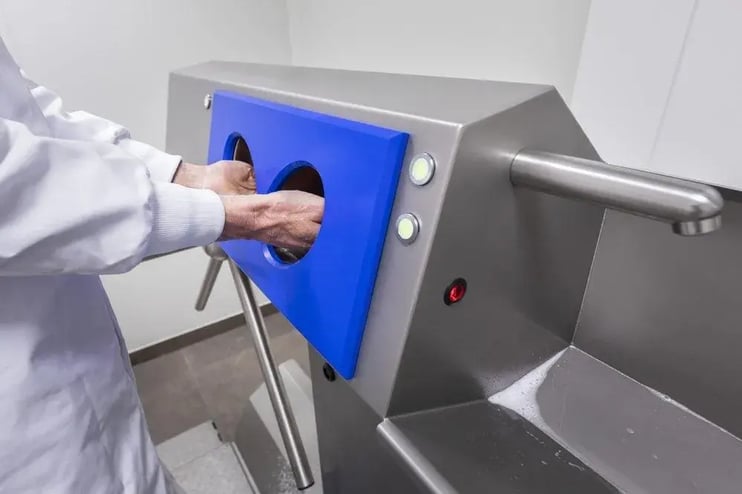The importance of good hand hygiene in the food industry

As a quality worker in the food industry, you know better than anyone how incredibly important good hygiene is. You want to comply with all laws and regulations and obtain the right certificates: all to ensure the promised quality. After all, a virus outbreak or pests would quickly bring production to a standstill and perhaps even worse – negative attention in the news. You want to avoid that. One of the most vital elements of hygiene in the food industry is hand hygiene. Because we touch everything with our hands. Why is this so crucial? And even more importantly, how do you ensure that all (new) employees adhere effortlessly to the regulations?
Number one transmitter of bacteria and viruses
Whether working on a cutting line, handling meat or packing crates: workers put their hands everywhere. Certainly in processes that are not yet automated. Fingers also come in contact with lots of things at home, during breaks and visits to the toilet. So our hands are also the number one transmitter of bacteria and viruses. That includes when gloves are worn because the wearers then touch the packaging with the gloves, contaminate the gloves with the virus and spread it after they’ve taken them off.
The danger of not having good hygiene
Whether at home, during a break or on a visit to the toilet: bacteria or viruses end up under a fingernail or on the skin in no time at all. In fact, microorganisms are all too happy to form colonies on the surface of the skin. Like the well-known ToBRFV virus found in tomato production, for example. If a worker carries this into a tomato nursery without realising it and touches a tomato, all the beautiful red tomatoes will discolour in next to no time. The ‘brown virus’ then strikes mercilessly. The result? Less yield and less profit. Double the waste. In the case of meat, fish and all other foods too, bacteria and viruses cause cross-contamination that results in food infections and illness. As a quality worker, you obviously want to avoid this. It's your job to ensure that all workers who enter the production area wash and disinfect their hands. Each and every time. And really thoroughly. But how can you be 100% sure of this? It begins by providing all the elements involved in hand hygiene, in the correct order.
This is how you sanitise hands in the food industry
Good hand hygiene consists of four parts. These are all equally important in the process:
- Soaping
- Washing
- Drying
- Disinfecting
The first step is to use the right hand soap. Soap ensures that dirt, bacteria and viruses are more easily removed from the hands. It is very important to allow the hand soap to work for 20 seconds. After soaping comes washing with water. This is essential because soap does not disappear on its own. Good washing and rinsing is therefore necessary. This is followed by the most underestimated part: drying. This is really very important. The hands must be bone dry before the worker disinfects them. In fact, disinfection doesn’t work if the hands are wet because the water acts as a kind of protective film on the skin. In this case, the disinfecting material will not adhere and cannot work properly. So: after soaping and washing, dry your hands really well first and only then disinfect them. Sounds easy. But why isn’t this done properly at so many companies?
Don’t make hand hygiene an option - it’s a must!
The rules for washing hands are posted on every door on the way to the production shop, are extensively described in the personnel manual and are briefed in depth during the induction of new workers. The wash basins are also ready and waiting with soap pump, dryer or tissues and the disinfectant. And yet it seems in practice that workers do not always put in the time and effort to follow this process properly. Each and every time, even after a break or trip to the toilet. Why is that? They are much less aware of the risks of poor hand hygiene and the serious consequences this can cause.
That’s why we believe in a mandatory hand cleaning process. With a hygienic entrance, soaping, washing, drying and disinfecting aren’t an option - they’re a must. Otherwise, a worker can’t enter the production shop. Drying with tissues is possible, but a hand dryer is the quickest and most hygienic solution. That saves having to buy paper and means less work refilling the dispensers and cleaning up. The turnstile opens only when disinfectant is used. All this together forms the hygienic entrance. As a quality worker and hygiene officer, you’ll find that this entrance saves you a great amount of work because the installations themselves manage the process. The only thing you have to do is ensure that the machines are set correctly and that they are kept clean and tidy; so you have a properly ensured hand hygiene process.
A tailor-made hygienic entrance
In a hygienic entrance, all workers soap, wash, dry and disinfect their hands - it’s contactless and mandatory! Each and every time. If you wish, the soles of shoes and boots can also be scrubbed. The best way to set up this entrance varies from business to business. It depends on the available space and how many people enter at a time. Fortunately, the process can be full customised and always fits – in your company, too. Are you curious to know what such a hygienic entrance looks like? Then watch this video. Or use our hygiene selector to determine which installation would suit your company the best.
Want to read more about hygiene in the food industry?
Personal hygiene goes beyond hand hygiene. Would you like all the stipulations, rules and solutions in one handy summary? Then take a look at this white paper: Personal hygiene in the food industry.
.webp)



.jpg?width=600&height=300&name=83203100%20-%20DZD-1000-R%20(3.1).jpg)
